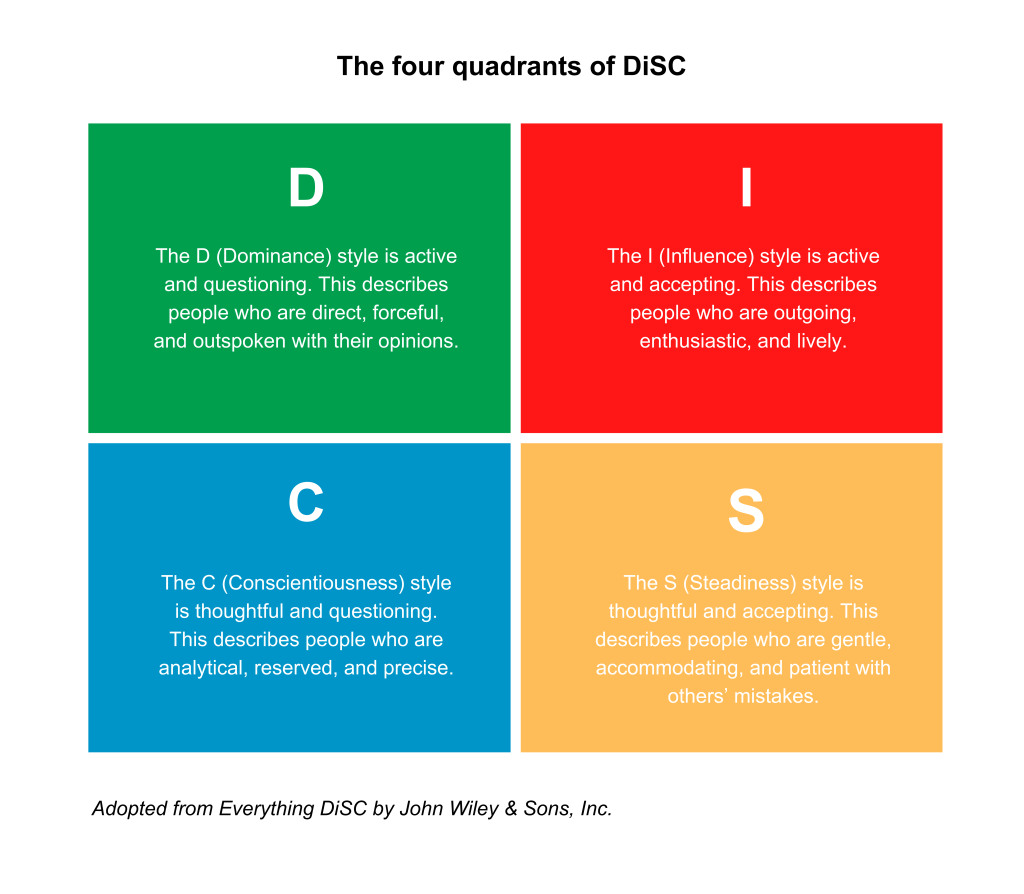By Suzana Aroko
Time management is one of the most essential skills for leaders. Yet, not every leader has mastered it. Understandably, leaders have a million things vying for their attention and time, which could lead to feelings of being overwhelmed or frustrated. In his “Focus: The Hidden Driver of Excellence”, Daniel Goleman, who is considered the father of emotional intelligence, regards directing attention towards where it needs to go as a primal task of leadership. For him, this ability rests on self-awareness. He describes self-awareness as: “An essential focus, one that attunes us to the subtle murmurs within that can help guide our way through life.”
In 1928, the psychologist William Marston came up with DISC theory to guide the journey towards self-awareness. The model, entailing four basic behavioural styles (Dominance, Inducement, Submission and Conscientiousness), eventually led to what is known today as DISC assessment/test. DISC assessments and tests have been used with great success by institutions, businesses and individuals around the world. UONGOZI Institute, for instance, employs it in almost every training programme to help leaders observe and investigate their internal states. At first, leaders are asked to rate themselves on the basis of four traits presented by the model. A group activity afterwards allows them to rate one another and also discover the gap between one’s own and others’ ratings.

I have taken the test three times (thanks to being part of the Institute), and each time ‘C’ was the predominant personality style then ‘S’. Along with this understanding of self also came a discovery of an intriguing relationship between personality traits and time management.
The D (Dominance) style features those who tend to be direct, decisive or driven. These individuals are goal-oriented and competitive and therefore they work at a break-neck pace to ‘get things done’. A D-style leader gravitates toward applying pressure on themselves and others when they feel things are moving at a “snail’s pace”. On the one hand, this can be beneficial to their organisation when it comes to moving things quickly. But on the other, quality may be jeopardised and their team’s productivity can go down due to what may be interpreted as ‘micromanaging’.
In the I (Influence) style, one finds people who do not shy away from conversations (sociable). They instantly trust others and are fond of working in teams. An I-style leader tends to be optimistic and enthusiastic when executing tasks. You will often hear them say: “Work doesn’t have to be boring,” or “Why don’t we make this fun?” They are good at motivating people to act and nurturing relationships. The downside of this style is that high optimism can easily become irrational exuberance: Over-promise versus under-deliver.
Peacemakers may be a good word to describe people with a S (Steadiness) style. They prioritise maintaining harmony and stability, providing support and collaborating with others. They are sympathetic, reliable, patient and consistent. S-style leaders thrive on multi-tasking and creating a supportive, positive team environment. As people pleasers, however, they tend to avoid confrontations and be indecisive. As such, they constantly feel overwhelmed by demands that could have been avoided by a simple NO.
People with C (Conscientiousness) styles (including myself) are described as private, analytical and logical. Because of our attention to detail, we are often deemed ‘perfectionists’. Do I agree? To some extent, I would place myself at 7 on a scale of 1 to 10 (with this being the most perfectionist) because I “let go” of things sometimes. C-style leaders are great listeners and problem-solvers. The former is attributed to their high levels of introversion, giving them an ability to engage in observation and uncover deeper, subtle meanings while in conversations. The latter is sculpted by their attention to detail to then conscientiously tackle an issue. On the negative side, when a C-style leader identifies a problem or risk, they may attempt to avoid or delay decisions based on it.
Each of these styles represents a unique focus and application. No style is better or worse than another. Ability to manage time is rather nurtured through finding the right balance between our strengths and limitations. As Richard Boyatzis, a renowned expert in leadership development and emotional intelligence, notes: “You need the negative focus to survive, but a positive one to thrive. You need both, but in the right ration.” Balance in this sense could mean learning when to show patience (D-style), avoid overpromising (I-style), say NO (S-style), and let things go (C-style). The knowledge gained from developing a greater understanding of human personality and behavior styles through DISC profiling can be translated into skill-sets, including better time management, that a leader can adopt to increase their personal levels of productivity and efficiency.






